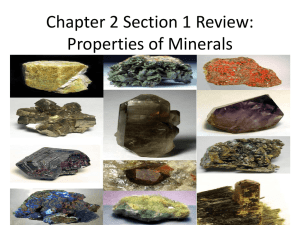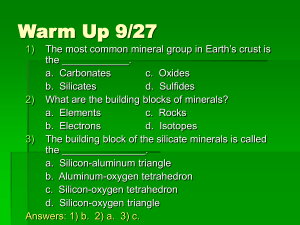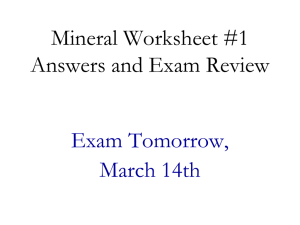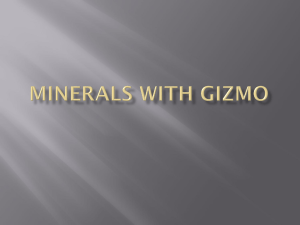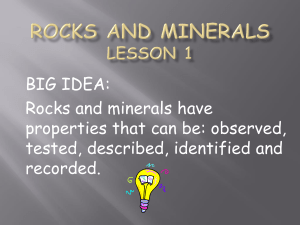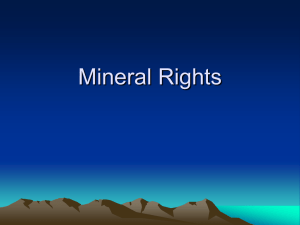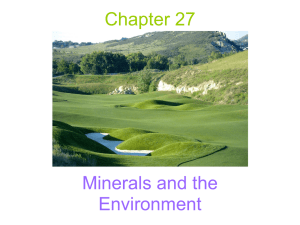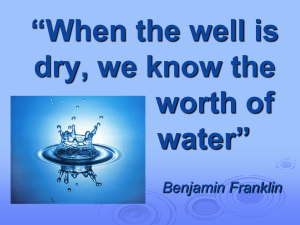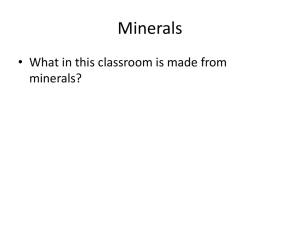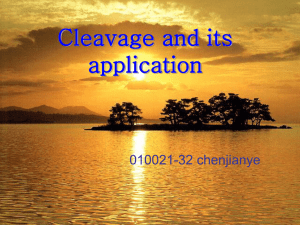The Physical Properties Of Minerals
advertisement
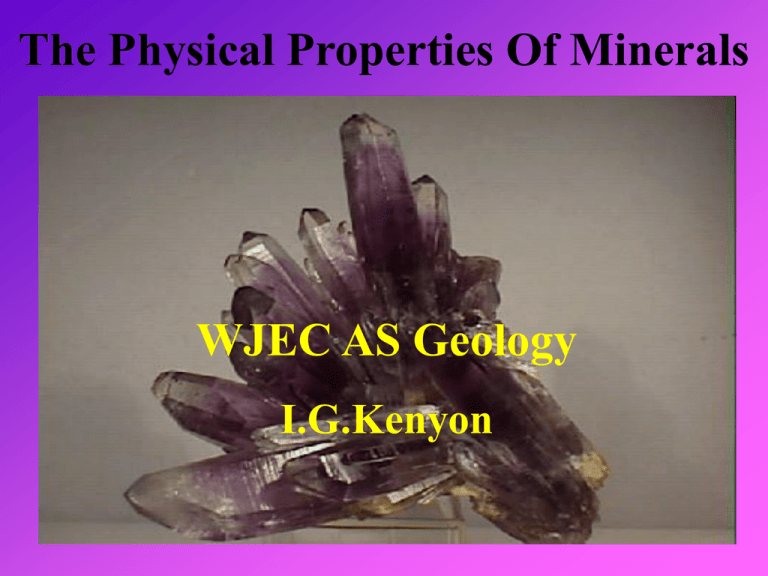
The Physical Properties Of Minerals WJEC AS Geology I.G.Kenyon Colour 1 • Determined by the chemical composition of the mineral • Minerals rich in Al, Ca, Na, Mg, Ba and K are often light coloured • Minerals rich in Fe, Ti, Ni, Cr, Co, Cu and Mn are often dark in colour 8cm Haematite, Kidney Ore Colour 2 5cm • Determined by the atomic structure of the mineral • Atomic structure controls which components of white light are absorbed or reflected • White minerals reflect all components of white light • Black minerals absorb all components of white light • Green minerals reflect green light and absorb the others Pyrite Cubes with Striated Faces Colour 3 •Colour is not particularly useful as a diagnostic property •Some minerals show a wide variety of colours •Quartz can be transparent, white, pink, brown, purple, yellow, orange and even black •Many minerals show very similar colours •Calcite, gypsum, barytes, fluorite, plagioclase feldspar and halite are commonly grey or white in colour Colour 4 Examples of colour variation in Fluorite Colour 5 Plagioclase feldspar Barytes Quartz Fluorite Calcite Gypsum All these minerals are grey or white in colour Transparency 2cm • When outlines of objects seen through it appear sharp and distinct •A good examples is Iceland Spar, a variety of calcite that is used for optical lenses •Iceland Spar also shows the remarkable property of double refraction Calcite – Iceland Spar • Determined by the atomic structure and chemical composition of the mineral Translucency 1 cm •The ability for a mineral to let light pass through it •Many minerals if cut thin enough will show some degree of translucency •Controlled by atomic structure and chemical composition •All transparent minerals are also translucent Fluorite Lustre 2cm The way in which a mineral reflects light Controlled by the atomic structure of the mineral Main types of lustre are Vitreous Metallic Pearly Resinous Adamantine Quartz – Vitreous Lustre Dull/Earthy Vitreous Lustre Fluorite Dog-Tooth Calcite The mineral reflects light like glass Sometimes glassy lustre is used instead of vitreous Metallic Lustre Malachite Galena Minerals reflect light like metals. Metallic lustre often tarnishes to a dull lustre Pearly Lustre Biotite Mica Muscovite Mica The lustre of a pearl or mother of pearl Shows clearly on the cleavage surfaces of biotite and muscovite mica Also shown by Talc and selenite (a variety of gypsum) Silky Lustre 1cm The lustre of silk Occurs in minerals with a fibrous structure Satin spar (a fibrous form of gypsum) shows this to good effect Gypsum (Satin Spar) Resinous Lustre 1cm The lustre of resin The mineral has a grainy appearance Sphalerite, opal and amber show resinous lustre Sphalerite (Zinc Blende) Adamantine Lustre 5mm The lustre of a diamond Dull or Earthy Lustre The mineral does not reflect light and has the same appearance as soil. 1cm Minerals such as galena have metallic lustres on freshly broken surfaces but they tarnish to dull with prolonged exposure to the atmosphere Limonite has a dull or earthy lustre Streak The colour of a mineral’s powder Obtained by rubbing a mineral specimen on an unglazed white porcelain tile Useful for identifying metallic ore minerals Silicates generally do not mark the tile and have no streak White minerals streaked on a white tile will have a white streak Haematite gives a cherry red streak Any minerals harder than the tile (6) will scratch it Streak 2 Malachite – pale green Galena – lead grey Haematite – cherry red Iron Pyrite – greenish black Sphalerite – pale brown Limonite – yellowish brown Metallic Ore Minerals – Characteristic Streaks Relative Density Measured relative to an equal volume of distilled water at 4 degrees centigrade. 1 litre = 1000g (1kg) 1 cubic centimetre = 1g Controlled by the atomic weight of the constituent atoms (chemical composition) and the packing (atomic structure) A useful property for identifying metallic ore minerals, these usually have relative densities over 5.0. The only non-metallic mineral which is quite dense is barytes (4.5) Most of the silicate minerals have densities between 2.5 and 3.2 Relative Density- Some Examples Kyanite 3.5-3.7 Gold 12.0-20.0 Fluorite 3.2 Iron Pyrite 4.9-5.2 Haematite 4.9-5.3 Gypsum 2.3 Hardness Measured on Moh’s scale from 1.0 (softest) to 10 (hardest) Talc 1.0 Diamond 10.0 Scale was devised by measuring the amount of noise and powder produced from rubbing a mineral on a metal file Moh’s Scale of Hardness 10 Diamond 9 Corundum 8 Topaz 7 Quartz 6 Orthoclase Feldspar Note diamond is over 30 x harder than corundum Moh’s Scale of Hardness 10. Diamond 7. Quartz 9. Corundum 8. Topaz 6. Orthoclase Feldspar Moh’s Scale of Hardness 5 Apatite 4 Fluorite 3 Calcite 2 Gypsum 1 Talc From 1 through to 9 on the scale, hardness increases in equal steps Moh’s Scale of Hardness 5. Apatite 2. Gypsum 4. Fluorite 3. Calcite 1. Talc Moh’s Scale of Hardness Steel nail 5.5-6.0 Fingernail 2.5 Copper coin 3.0 Window glass 5.0 Everyday objects can be substituted for minerals on Moh’s scale Testing For Hardness Try to scratch mineral specimens with substances of known hardness If a mineral is not scratched by your fingernail, but is scratched by a copper coin then it will have a hardness of 2.5–3.0 If a mineral cannot be scratched by steel it has a hardness of over 6.0 Gypsum is scratched by a fingernail, hardness <2.5 Mineral Hardness Smaller atoms/ions promote greater hardness in minerals generally Minerals with large ions such as carbonates and sulphates are soft Atomic structure and bond type also control hardness. Covalent bonds are generally stronger than ionic ones Hardness should not be confused with difficulty of breaking-a hard mineral may be very brittle Graph to illustrate difference between Moh’s Scale and Knoop numbers Fracture The way a mineral breaks when struck by a hammer The type of fracture is not controlled by any weaknesses in the atomic structure of the mineral Types of Fracture Conchoidal – Like Glass Even – Flat fracture surface Uneven – Irregular fracture surface Hackly – Very jagged like cast iron Fracture is only described when the mineral has no cleavage Conchoidal Fracture This type of fracture is the same as that shown by window glass A series of concentric curved lines can be seen on the fractured surface 5mm Rose quartz showing conchoidal fracture A diagnostic property of the mineral quartz Cleavage The way a mineral breaks when struck by a hammer Cleavage is controlled by lines of weakness in the atomic structure of the mineral Minerals can have 1, 2, 3 or 4 planes of cleavage 1 plane, parallel or basal cleavage 2 planes of cleavage that intersect at a characteristic angle 3 planes (cubic, rhombohedral) 4 planes, octahedral cleavage Parallel or Basal Cleavage 1cm 1cm Biotite Mica Barytes One plane of cleavage enables the mineral to part along parallel lines. It is analogous to a ream of paper that can be separated into individual sheets. Minerals Showing 2 Sets of Cleavage Planes 1cm 1cm Augite Plagioclase Feldspar Feldspars – intersect at 90 degrees Augite (Pyroxene) – intersect at 90 degrees Hornblende (Amphibole) – Intersect at 60/120 degrees Prismatic Cleavage 1cm Produced by the intersection of three cleavage planes Halite 1cm Cubic cleavage 3 planes intersect at 90 degrees e.g. halite Rhombohedral cleavage 3 planes intersect at 60/120 degrees e.g. calcite Calcite Octahedral Cleavage Cleaved edge of cubic crystal Fluorite shows well developed octahedral cleavage 1cm Cleavage Surface Octahedron The cubic crystals are truncated across their corners at 45° by four cleavage planes This can eventually lead to the formation of octahedrons from the original cubic crystals Acid Reaction Use dilute hydrochloric acid to test for carbonates Calcite effervesces (fizzes) and gives off carbon dioxide gas Calcite reacting and giving off carbon dioxide 2cm Taste If a mineral can be tasted in the mouth, then it is soluble in fresh water Halite (rock salt) tastes salty and is a diagnostic property of the mineral Striking Fire With Steel Pyritohedrons Iron Pyrite (Fools Gold) sparks when struck with a steel hammer and releases a sulphurous odour Iron Pyrite was used as flints in flintlock pistols to ignite the gunpowder Pyrite cubes Magnetism 1cm Steel pins and magnet attracted to magnetite Octahedral crystals of Magnetite The ability of a mineral to attract iron filings and pick up steel pins Magnets stick to magnetite quite readily and is the only strongly magnetic mineral found at the earth’s surface Feel A characteristic sensation experienced when a mineral is held and rubbed between the fingers 2cm Graphite feels very cold upon the touch as it is a very good conductor of heat 2cm Talc feels very greasy when rubbed between the fingers Schiller Effect or Iridescence The mineral shows a ‘play of colours’ on the surface–similar to the effect of oil/petrol spills in water Produced by the scattering of light by fine planar zones of compositional variation called exsolution lamellae 2cm Example labradorite, a common variety of plagioclase feldspar Form or Habit Amorphous Chalcopyrite Crystallised Iron Pyrite This refers to the common appearance of the mineral and varies from crystallised to amorphous or massive Variations in Habit/Form/Appearance of Minerals Variations in Habit/Form/Appearance of Minerals Habit – Botryoidal/Mammilated The specimen has spherical; lumps or mounds encrusting the surface Botryoidal – the lumps or mounds are less than 2mm in diameter 1cm Mammilated Haematite Mammilated – the lumps or mounds are over 2mm in diameter (‘breast-like’) Habit – Stalactitic, Fibrous and Radiating 1cm 2cm Haematite showing stalactitic form with fibrous and radiating internal structure Habit - Acicular 2cm The mineral occurs as thin needle-like crystals Examples chiastolite, tourmaline, andalusite and kyanite 2cm Chiastolite Kyanite Habit - Crystallised 1 cm Rhombdodecahedral Garnet Crystals Habit – Nodular, Fibrous and Radiating 1cm Iron Pyrite showing nodular habit with fibrous and radiating internal structure Habit – Foliate/Lamellar 1cm Muscovite Mica showing foliate/lamellar habit Habit - Tabular 1cm Tabular mass of Barytes crystals Habit - Bladed 2cm Randomly oriented barytes crystals up to 8cm long Habit - Reticulate 1cm Interlocking framework structure resembling a delicate snowflake shown by Cerussite from Tsumeb, Namibia Habit – Dendritic/Arborescent Manganese oxide dendrites on limestone, Solnhofen, Germany Diagnostic Properties Those properties that allow any mineral to be identified Most minerals have two to four diagnostic properties Hardness, cleavage, streak and habit are most useful Colour, lustre, transparency and density are less useful Special properties such as acid reaction, taste, magnetism, striking fire with steel and feel are often used to identify a mineral The End
